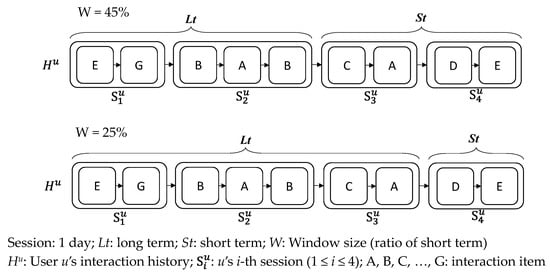You're using an outdated browser. Please upgrade to a modern browser for the best experience.
Please note this is a comparison between Version 1 by Ming-Yen Lin and Version 3 by Rita Xu.
Recommendation mechanisms have emerged as vital tools for the filtering of information in various aspects of life. They are widely used in commercial platforms, including e-commerce sites like Amazon. Session-based or session-aware recommendation is more attractive due to the recommendation accuracy. This study investigates the integration of short-term and long-term preferences in the RNN based methods.
- recommender system
- session-aware recommendation
- latent-context information
1. Introduction
Our preferences and purchases change over time. To ensure the recommended results align more closely with actual needs, the sequential recommendation system (SRS) has gained prominence [1]. SRS emphasizes continuous interaction records with time-series characteristics, based on the assumption that dependencies exist between interactions. Therefore, all user interaction records are essential for a comprehensive understanding. Traditionally, research in this area often used the recurrent neural network (RNN) as the network architecture, yielding positive results [2][3][4][2,3,4].
The sequential recommendation method utilizes a series of interaction records as its reference basis. To avoid learning incorrect information from irrelevant interaction records, the concept of a session has been introduced. Interaction records within a defined period are considered part of the same session, with interactions processed separately based on the session. This led to the development of both session-based and session-aware recommendations.
The session-based recommender system (SBRS) [2][5][6][2,5,6] aims to reflect users’ actual thinking and behavior patterns. It considers only the interaction records within a short period, meaning recommendations are based solely on one session’s data. This approach’s limitation is its reliance on a narrow data range, leading to less personalized recommendations. It is, however, beneficial for users seeking recommendation system convenience without needing to register or log in.
To facilitate personalized recommendations, the session-aware recommender system (SARS) was developed [7]. SARS involves recommendations comprising multiple sessions [8][9][10][11][8,9,10,11]. Personalized recommendations typically rely on the user’s current interaction to infer their short-term behavioral intentions. While short-term behaviors significantly influence future interests and are thus considered short-term preferences, sessions too distant from the short-term period are classified as long-term preferences. Users have both long-term and short-term preferences integrated into their overall intention preference for recommendations [1][11][1,11]. This method’s limitations include overlooking context information and a rigid definition of short-term preferences based on the last session, which can limit recommendation adaptability.
The correlation between a product and the current product represents potential information that should be considered in understanding the real intentions of consumers. Additionally, previous studies have often limited the definition of short-term preferences to the last session [11]. This approach can lead to recommendations that are too rigid and inflexible. This rigidity arises because a session’s definition is based on time intervals, as mentioned earlier. If a user’s intentions span a period that extends beyond the confines of a single session, this behavior pattern may not accurately represent the user’s true intentions.
Addressing the relevance of auxiliary contextual information to sequential interaction records, the hidden state in the gated recurrent unit (GRU) is suggested to be used as the model’s contextual information [1]. This method ensures the generated contextual information, based on past interaction records, is relevant. It also mitigates the issue of the RNN framework forgetting older information in long-sequence data.
To address the rigidity of defining long-term and short-term user preferences based on session duration, rwesearchers propose a flexible window-based approach. This method utilizes a designated percentage of a user’s interaction history to categorize preferences. For example, as illustrated in Figure 1, by setting the window (W) at 45%, reswearchers consider 45% of the interaction records closest to the most recent interaction as indicative of short-term preferences. The remaining interactions are categorized as long-term preferences. This approach more accurately reflects the user’s actual preferences by dynamically adjusting the range between long-term and short-term interactions.

Figure 1. Long-term vs. short-term preferences by varying window scope.
